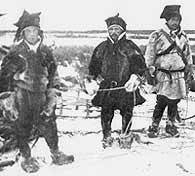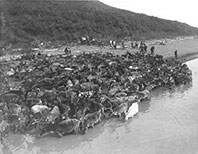
|
|
|
|
1898 continued: On March 16 The Seminole, an old sailing ship, transports the group to Alaska. It must be towed the entire way. The women and children stay in Fort Townsend, Alaska, and 57 men and the 527 reindeer continue on to Haines, Alaska. There is no shelter for the men nor lichen for the reindeer when they arrive March 27. The starving, weakened reindeer and the men lead by Redmyer, begin a 1,500 kilometer trip through the tundra toward Circle City in the Yukon Valley. Makeshift tents are used for shelter - the first Sami lavvus to be constructed in North America. Lichen is found along the way, but after their period of starvation the reindeer can no longer digest food and 311 starve to death or are killed by wolves. On June 22, the remaining 71 leave Washington in two ships for Eaton Station at Unalakleet. One group arrives July 30th and the other group the next day. They begin moving supplies and building a permanent station. Herders and 400 reindeer under the direction of W.T. Lopp are dispatched from Teller to Point Barrow to rescue the crews of eight iced-in whaling ships. The rescue team arrives to discover that the Inuit and other local residents have rescued the crews. The reindeer stay on and the Point Barrow Reindeer Station is established. 1899: On February 28, the herders and Redmyer finally arrive at Circle City. Of 527 reindeer, only 114 have survived. The Army takes some of them to use as draft animals. The Manitoba Expedition is no longer needed for War Department rescue work and are placed under the command of the Interior Department. Gold is discovered at Anvil Creek by two Swedes, Erik Lindblom, and John Brynteson (briefly a member of the Reindeer Project), and a Kven, Jafet Lindeberg, who has left the Reindeer Project to pan for gold. The three become known as "The Lucky Swedes" and earn great fortunes by sluicing. Lindeberg stakes his claim at Anvil City, or "No-name," which becomes the town of "Nome." Many Sami leave the Reindeer Project to become US citizens and pan for gold, and some become mail carriers. Reindeer are used as draft animals and food, both for the mining operations and for the postal service. Samuel Balto stakes three claims. He is offered $1000 for the claim at "Balto Creek" but refuses. A measles epidemic breaks out. Half of the Inuit on the Seward Peninsula, including many of the herders, catch the disease from the miners and die. Jackson establishes the first Alaskan postal route from St. Michael to Kotzebue, and another route from Eaton Station to Nome is managed by Kjellmann. The reindeer revolutionize mail delivery. Stations are set up and reindeer carrying 200-300 pounds of mail run relays of 30-50 miles. The distance between Circle City and Juneau that had taken 60 days, takes six with pulkas drawn by reindeer. And while the dog teams have needed an expensive food supply, reindeer can eat at no cost along the route. Many Sami and Inuit go to work for the postal service. 1900: On February 4, Per Mathison Spein marries Ellen Maria Sara Kvamme, the first wedding of the Reindeer Project. Summer 1900 is known as the peak of the Gold Rush and there are 30,000 miners in Nome. Lindeberg sends for Leonard Seppala, a Kven from Skjerv°y, Norway, to help in his mining operations. There are 7000 reindeer in Alaska. 1901: Mary Antisarlook, an Inuit interpreter for Jackson, inherits her husband Charlie's reindeer herd of 360 when he dies in the measles epidemic. They are earned from his apprenticeship at Teller Station. Antisarlook moves the reindeer to Unalakleet and the herd grows to 1500, earning her the nickname of "Mary, the Reindeer Queen." The Tungese people of the Okhotsk region in Siberia bring 254 reindeer to Teller Station. They are larger animals and interbreed with those already there. Johan Tornensis leaves Alaska to become the first of the Alaska Sami to settle in Kitsap County, Washington. Others from the group will follow him there. 1902: Russia refuses to sell more reindeer to Alaska. 1904: Reindeer stations are now connected to the missions at Point Barrow, Kotzebue, Wales, Gambell, Teller, Golofnin, Unalakleet, Eaton, Bethel and Nulato. Whites are not allowed to own breeding stock or female reindeer. The Sami, being neither white nor Eskimo, have a separate arrangement with the US government. 1906: Paul Xavier, a Tornesis from Kautokeino, and the uncle of Johan Tornensis in Alaska, moves from the Midwest to Parkland, Washington. A Lutheran minister re-named after a missionary, he helps found Pacific Lutheran College; his granddaughter Dagney will marry Fredric Schiotz, the longtime president of the Lutheran Church in America. Finding more reindeer are owned by the missions and whites than by Inuits, the US Department of the Interior publishes a report critical of Sheldon Jackson. Jackson resigns for this and other reasons. 1910: There are now more than 27,000 reindeer in Alaska. 1912: Congress makes Alaska a United States territory. 1913: The Inuits suffer increasing hardships due to the depressed condition of the whaling business. |
![]()
Copyright
©
2001
B┴IKI:
the North American Sami Journal
All rights reserved



